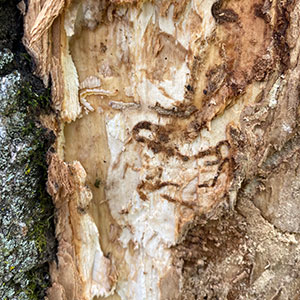By Pat Melgares, K-State Research and Extension news service
The Kansas Forest Service has confirmed the presence of the emerald ash borer on a private residence in Nemaha County, the second new sighting found in a Kansas county this year.

KFS, working with the Kansas Department of Agriculture and K-State Research and Extension, confirmed a live insect on Oct. 14. Officials say the pest had been suspected in the area for several years, but only recently have they found a live insect, which is required to make the detection official.
Earlier in 2024, state officials confirmed the presence of the emerald ash borer in Lyon County.
The emerald ash borer is an exotic, invasive beetle from eastern Russia and northeastern Asia that likely was brought to the U.S. in infested packing material. The beetle threatens urban and rural forests by killing North American ash species and their cultivars.
KFS officials note that at least 70 million ash trees have already been destroyed due to the emerald ash borer, and as many as 9 billion North American ash trees will eventually be functionally rooted out and destroyed from the continent.
The discovery in Nemaha County makes 15 Kansas counties in which the emerald ash borer has been confirmed, including Wyandotte (2012), Johnson (2013), Leavenworth (2014), Douglas (2015), Jefferson (2015), Atchison (2016), Doniphan (2017), Shawnee (2017), Miami (2019), Jackson (2019), Brown (2022), Osage (2022), Franklin (2023) and Lyon (2024).
See map of current counties affected in Kansas.
Forest officials say landowners should learn the signs and symptoms of emerald ash borer in their ash trees, including thinning canopies. As the feeding progresses, trees may begin to sucker (a process called epicormic sprouting) where branches appear near the trunk or lower canopy. Eventually, small D-shaped holes may appear in the bark.
Landowners are encouraged to create a replacement plan for the ash trees on their property to ensure a continually healthy canopy as ash trees decline. A landscape with many types of trees is more resilient to insect, disease and environmental threats that exist or could occur in the future.
Those seeking treatment or removal of ash trees in a county where the insect has already been detected should consult an arborist. A listing of certified arborists in Kansas is available online.
Landowners, especially those in counties where the insect has not already been detected, are encouraged to report suspected cases of emerald ash borer to the Kansas Department of Agriculture, or to the Kansas Forest Service.
All Kansans are reminded of the recommendation to avoid bringing firewood from another state or county where emerald ash borer has been previously detected. Use local sources for firewood.
The Kansas Forest Service, in partnership with K-State Research and Extension, continues to offer workshops and educational training in counties with detected populations of emerald ash borer, as well as those communities not yet affected by the pest.
More information on resources about treatment of infected trees is available online from the Kansas Forest Service.
 The 74th Annual Kansas Turf & Landscape Conference will be held on December 4 & 5 (Wednesday and Thursday) at the Hilton Garden Inn, Manhattan. The conference is an excellent way to learn about turf and landscape management, visit with old friends, network with new ones, and see all the latest products and supplies from local and national vendors.
The 74th Annual Kansas Turf & Landscape Conference will be held on December 4 & 5 (Wednesday and Thursday) at the Hilton Garden Inn, Manhattan. The conference is an excellent way to learn about turf and landscape management, visit with old friends, network with new ones, and see all the latest products and supplies from local and national vendors.






 Increased levels of humidity make this worse as the high water content of the air hampers the evaporation of sweat on your skin. This can result in heat exhaustion or heat stroke. Those most at risk for heat illness include infants, children, the elderly, overweight people and those who are ill or have certain medical conditions such as high blood pressure.
Increased levels of humidity make this worse as the high water content of the air hampers the evaporation of sweat on your skin. This can result in heat exhaustion or heat stroke. Those most at risk for heat illness include infants, children, the elderly, overweight people and those who are ill or have certain medical conditions such as high blood pressure.

